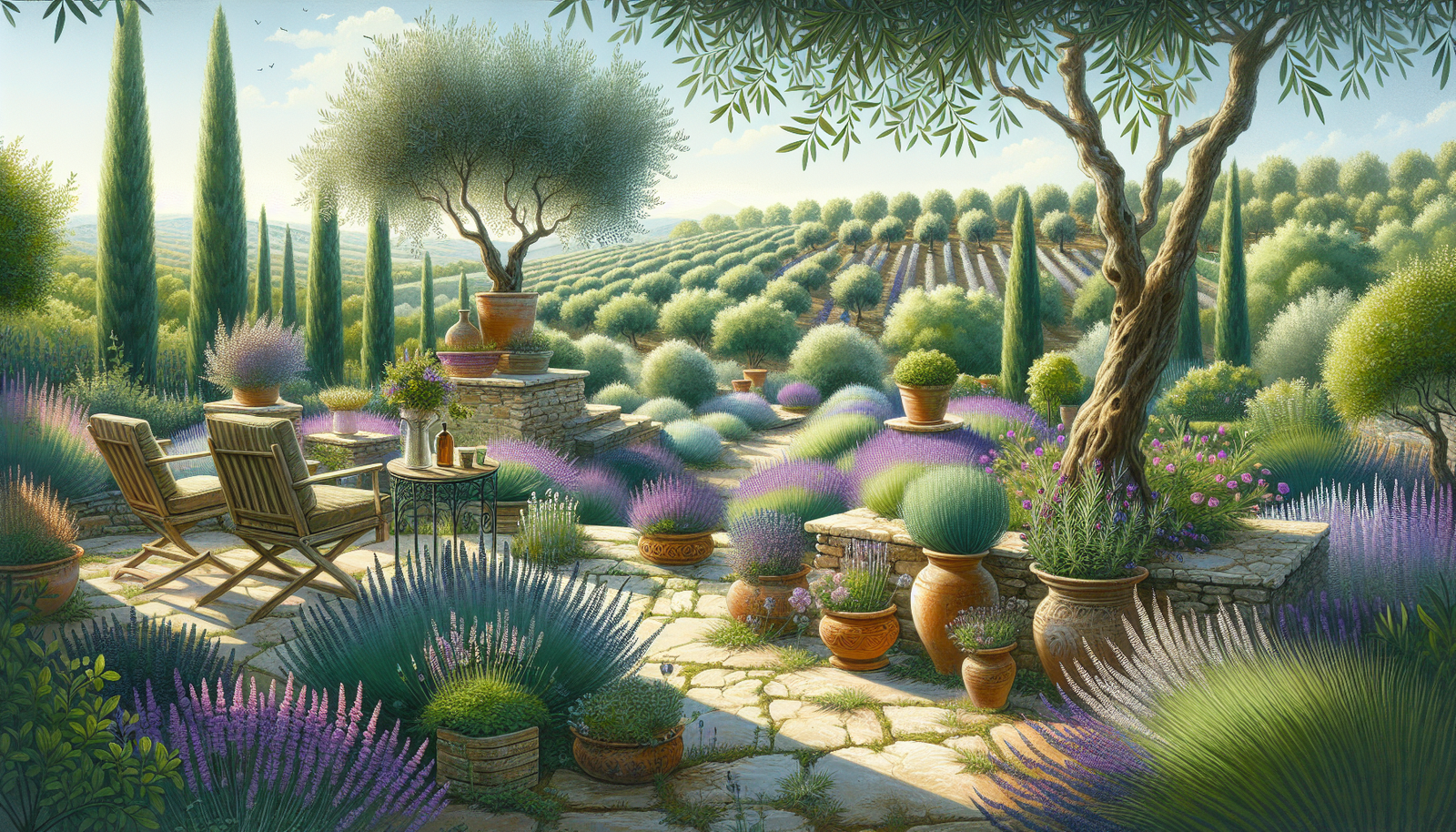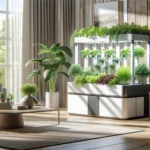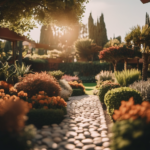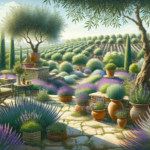Prepare to embark on a visual journey through the lush landscapes and picturesque charm of Mediterranean style garden designs within the article, «Diseños De Jardines De Estilo Mediterráneo: Colores Y Plantas Que Inspiran». This piece is rich with vibrant imagery and inspirations, illuminating the striking colors and diverse range of plants that define this unique style of garden design, from the texture of rough terracotta pots bursting with bright bouquets to the gentle lapping of water against a stone fountain. Your senses will be transported into the world of Mediterranean serenity and its sublime beauty, letting your imagination create a dreamy paradise right in your backyard.
Understanding the Mediterranean Garden Style
Creating a Mediterranean garden is about much more than just styling your garden with specific plants. A Mediterranean garden is a concept that combines specific elements to reproduce the ambience and charm of Mediterranean landscapes. This style of garden design is ideal for regions with similar climatic conditions.
Concept of Mediterranean garden design
Mediterranean garden design is based on the principle of simplicity and functionality. It tends to focus on robust, hardy plants and materials that can withstand the strong sun and winds, as well as brief, intense bouts of rain. The key is to focus on creating a space that’s relaxing, refreshing and easy to maintain.
Key elements of Mediterranean garden style
The main elements of a Mediterranean garden style include dry walls, rustic furniture, vibrant flowers, aromatic plants, and water features. They are generally designed with a casual, relaxing vibe, and include many places to sit and enjoy the surroundings. These gardens often have rustic charm, combining traditional elements with plant and color selection.
Characteristics of Mediterranean Plants
There’s a certain visual quality that is unique to Mediterranean plants. From their silver-green foliage to their distinctive growth habits, they evoke a sense of timeless elegance and rustic charm.
Adaptations to Mediterranean climate
Mediterranean plants have unique adaptations that make them suited to hot, dry summers and rainy winters. For example, many have small, hardy leaves to conserve water. Others like the Mediterranean fan palm develop deep root systems to tap into groundwater during prolonged dry periods.
Growth habits and appearance
Native Mediterranean plants typically have growth habits that help them to thrive in difficult conditions. Many are shrubs that grow low to the ground, while others sport tall, slender profiles perfect for catching a light sea breeze. Many Mediterranean plants also have attractive, aromatic foliage and bright, vibrant flowers.
Aromatic properties
Many Mediterranean plants are aromatic, releasing intoxicating scents when their leaves are disturbed. This is especially true for herbs like rosemary, thyme, and lavender. These plants often release their fragrances during the heat of the day, adding an unexpected sensory delight to the garden setting.
Popular Mediterranean Garden Plants
Several types of plants are synonymous with the Mediterranean garden style. These include olive trees, lavender, rosemary, and cypress trees, among others.
Olive trees: An iconic plant
Olive trees are an iconic symbol of the Mediterranean. Their silver-green leaves and gnarled trunks add a touch of rustic charm to any garden, while their fruit is both nutritious and delicious. Olive trees are drought-tolerant, making them a great choice for dry, arid areas.
Lavender: Fragrance and color
Lavender is hardy, versatile and, most importantly, stunning. Its bold purple flowers and silver foliage make it a star in any Mediterranean garden. The plant is well known for its wonderfully addictive fragrance, which is said to have calming properties and is commonly used in perfumes, soaps, and sachets.
Rosemary: A versatile shrub
The rosemary bush with its needle-like leaves and blue flowers is an ideal choice for a Mediterranean garden. Rosemary is extremely hardy and can survive poor soil conditions, irregular watering, and full sunlight. Apart from its culinary uses, it’s also recognized for its distinctive fragrance appealing to many garden owners.
Cypress trees: A symbol of the Mediterranean
Cypress trees are emblematic of Mediterranean landscapes. They are tall, columnar trees, perfect for creating privacy and adding vertical lines in your garden. Their dense, dark-green foliage contrasts beautifully with the silver-green of olive trees and aromatic herbs.
Color Palette for Mediterranean Gardens
Mediterranean gardens are synonymous with a vibrant color palette, drawing inspiration from the natural landscape.
Influence of natural landscape color palette
The Mediterranean color palette is inspired by its incredible landscape. Earth tones of terracotta and stone merge with the electric blues of the sea and sky, and these are all reflected in the plants chosen for a Mediterranean garden. Olives’ silvery greens, vibrant purples of lavender, and the russet tones of shrubs and trees all come together to form an irresistible tableau.
Importance of blues, greens, and earth tones
Blue and green hues help to create a refreshing environment that counteracts the heat and intensity of summer weather. These cool colors can appear in the garden in the form of plants, mosaics, or painted features. Earth tones ground the design, with the warm colors often used for walls, paths, and patio areas, tying together the Mediterranean look.
How to use color to enhance mood and ambiance
In a Mediterranean garden, color is used to enhance mood and ambiance. Warm colors induce a sense of warmth and coziness, while cool colors impart a calming, peaceful vibe. To add depth and interest, aim for a mix of primary and secondary colors.
Incorporating Water Features
Water is a vital element in Mediterranean garden design. It provides respite from the heat, adds visual interest, and can also serve a practical purpose.
Role of water in Mediterranean gardens
Water features provide a focus and a soothing soundtrack to garden life. They can be as simple as a bird bath or as elaborate as a cascading waterfall or fountain. The sight and sound of water can provide a calm and tranquil space in your garden, providing a perfect place to sit and relax.
Types of water structures
There are various types of water structures that you can incorporate into your garden. Traditional choices include fountains, bird baths, and ponds. Alternatively, you could consider a water wall, a stream, or even a swimming pool if space allows.
Placement and design for aesthetic and functional benefits
Placement of water structures can greatly impact the overall look and feel of the garden. For instance, a centrally placed fountain can act as a focal point, while a pond placed in a quiet corner can create a peaceful retreat. Water features can also provide a watering hole for local wildlife, improving the garden’s ecosystem.
Creating a Mediterranean Patio
A Mediterranean Patio is a vital component of a Mediterranean garden. It provides a welcoming space to sit, relax, and enjoy the garden’s beauty.
Choosing the right furniture and accessories
Choose rustic furniture in natural, earthy tones to reinforce the relaxed Mediterranean atmosphere. Wrought-iron furniture, ceramic pots, and richly textured rugs can enhance the patio’s visual appeal. Tropical plants in pots and vibrant cushions can add splashes of color.
Consideration of shade
In a Mediterranean garden, shade is a crucial factor. Consider incorporating a pergola, vines, shade cloth, or a large umbrella to provide relief from the sun.
Tips for creating an inviting outdoor living space
To create an inviting outdoor space, focus on comfort. Choose comfortable furniture and ensure there are plenty of soft, plush cushions and blankets for those chillier evenings. Lighting is essential too – try fairy lights or lanterns for a warm, welcoming glow at night.
Use of Hardscaping in Mediterranean Gardens
Hardscaping in a Mediterranean garden involves using non-living elements such as rocks, stones, and pathways to create a unique garden landscape.
Role of stones, rocks, pebbles and pathways
Stones, rocks, pebbles, and pathways can add structure and visual interest to a Mediterranean garden. Apart from being decorative, hardscaping with these materials can help manage water runoff, reduce soil erosion, and assist in keeping the garden low maintenance.
Grottos and other stone structures
Grottos and other stone structures can help create mini landscapes within the garden, adding depth and dimension. They can also provide habitats for local wildlife, contributing to biodiversity.
Balancing hardscape with plantings
While hardscaping plays a crucial role in garden design, it needs to be balanced with plantings. For instance, soften the look of stone walls or pathways with creeping plants, or use shrubs to break up a large expanse of rock.
Mediterranean Container Gardening
Container gardening opens up possibilities for garden enthusiasts with limited space to enjoy the Mediterranean style.
Container choice and placement
Terra-cotta pots are a classic choice for this type of garden. Placing your pots in clusters can create lovely mini landscapes, while carefully positioning larger containers can provide structure and focal points.
Plant selection for pots and planters
A variety of Mediterranean plants can be grown in containers. These include herbs like rosemary, thyme, and basil, as well as flowering plants like lavender and geraniums. Succulents are also a great option as they are low maintenance and supply interesting textures and colors.
Advantages of container gardening in a Mediterranean garden design
Container gardening in a Mediterranean garden comes with several benefits. It allows flexibility as one can move, replace, or rejig plantings as needed. Additionally, it enables the growth of a more significant range of plants, some of which that wouldn’t necessarily thrive if planted in the ground.
Maintaining a Mediterranean Garden
While Mediterranean gardens are designed to be low maintenance, certain tasks can keep your garden healthy and attractive.
Watering and general care
As Mediterranean plants are adapted to a dry climate, they generally require less frequent watering. However, certain periods, especially during establishment and in particularly dry spells, may require attention. Regular pruning can help maintain plant health and aesthetics.
Maintaining year-round interest
While Mediterranean gardens are best known for their summer allure, they can also provide interest throughout the year. Evergreen shrubs like rosemary and lavender provide structure and foliage throughout the year, while others like cypress trees feature interesting bark for winter appeal.
Dealing with pests and diseases
Mediterranean plants are generally quite resistant to pests and diseases, but it’s always essential to keep an eye out for signs of trouble. Some common issues might include fungal diseases due to over-watering, or problems like aphids or whiteflies.
Inspirational Mediterranean Garden Designs
Looking at examples of successful Mediterranean garden designs can be highly instructive and inspiring.
Gardening layouts and design principles
In Mediterranean garden designs, plants are usually arranged casually rather than in rigid patterns. The key design principles include the use of local materials, water conservation, and creating a strong indoor-outdoor connection that encourages relaxation and enjoyment of the space.
Case studies of well-designed Mediterranean gardens
Look out for examples of Mediterranean gardens in garden design books, magazines, and online resources. Note what works well and adapt it to your circumstance.
Personalize your own Mediterranean garden
Every gardener brings their personal flair to their garden, and it’s no different with a Mediterranean garden. Experiment with colors, fragrance, and texture to create a garden that reflects your personality. Whether it’s a small rooftop garden or a sprawling estate, the Mediterranean garden style can transport you to a world of warmth, charm, and relaxed sophistication.






